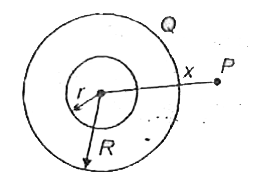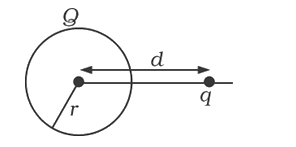Acidified water from certain reservoir kept at a potential V falls in the form of small droplets each of radius r through a hole into a hollow conducting sphere of radius a. The sphere is insulated and is initially at zero potential. If the drops continue to fall untill the sphere is half full, the potential acquired by the sphere is
a2V2r2
√arV2
a3V2r3
aVr
The correct Answer is:A
To solve the problem step-by-step, we need to analyze the situation involving the droplets falling into the hollow conducting sphere and how this affects the potential of the sphere.
Step 1: Understand the Problem
We have a hollow conducting sphere of radius a that is initially at zero potential. Acidified water droplets of radius r fall into this sphere from a reservoir at potential V. We need to find the potential of the sphere when it is half full of these droplets.
Step 2: Calculate the Volume of the Sphere
The volume Vs of the hollow conducting sphere when it is half full can be calculated using the formula for the volume of a sphere:
Vs=23πa3
Step 3: Calculate the Volume of One Droplet
The volume Vd of one droplet (which is spherical) is given by:
Vd=43πr3
Step 4: Determine the Number of Droplets
To find the number of droplets n that fit into the half-full sphere, we equate the total volume of the droplets to the volume of the sphere:
n⋅Vd=Vs
Substituting the volumes we calculated:
n⋅43πr3=23πa3
Now, simplifying this equation:
n⋅43r3=23a3
n=2a34r3=a32r3
Step 5: Calculate the Charge of the Droplets
Each droplet has a charge q due to the potential V of the reservoir. The charge q can be expressed as:
q=V⋅Vd=V⋅43πr3
Step 6: Calculate the Total Charge in the Sphere
The total charge Q in the sphere when it is half full is:
Q=n⋅q=(a32r3)⋅(V⋅43πr3)
Simplifying this gives:
Q=a32r3⋅V⋅43πr3=2πa3V3
Step 7: Calculate the Potential of the Sphere
The potential V′ of the sphere when it is half full can be calculated using the formula for the potential due to a charge Q at a distance a:
V′=14πϵ0⋅Qa
Substituting Q:
V′=14πϵ0⋅2πa3V3a=14πϵ0⋅2πa2V3
This simplifies to:
V′=2a2V12ϵ0=a2V6ϵ0
Final Answer
Thus, the potential acquired by the sphere when it is half full is:
V′=a2V6ϵ0
We have a hollow conducting sphere of radius a that is initially at zero potential. Acidified water droplets of radius r fall into this sphere from a reservoir at potential V. We need to find the potential of the sphere when it is half full of these droplets.
The volume Vs of the hollow conducting sphere when it is half full can be calculated using the formula for the volume of a sphere:
Vs=23πa3
The volume Vd of one droplet (which is spherical) is given by:
Vd=43πr3
To find the number of droplets n that fit into the half-full sphere, we equate the total volume of the droplets to the volume of the sphere:
n⋅Vd=Vs
Substituting the volumes we calculated:
n⋅43πr3=23πa3
Now, simplifying this equation:
n⋅43r3=23a3
n=2a34r3=a32r3
Each droplet has a charge q due to the potential V of the reservoir. The charge q can be expressed as:
q=V⋅Vd=V⋅43πr3
The total charge Q in the sphere when it is half full is:
Q=n⋅q=(a32r3)⋅(V⋅43πr3)
Simplifying this gives:
Q=a32r3⋅V⋅43πr3=2πa3V3
The potential V′ of the sphere when it is half full can be calculated using the formula for the potential due to a charge Q at a distance a:
V′=14πϵ0⋅Qa
Substituting Q:
V′=14πϵ0⋅2πa3V3a=14πϵ0⋅2πa2V3
This simplifies to:
V′=2a2V12ϵ0=a2V6ϵ0
Thus, the potential acquired by the sphere when it is half full is:
V′=a2V6ϵ0
Topper's Solved these Questions
- BOOK - RESONANCE ENGLISHCHAPTER - ELECTROSTATICSEXERCISE - Part- II20videos
ELECTROSTATICS
- BOOK - RESONANCE ENGLISHCHAPTER - ELECTROSTATICSEXERCISE - Part - IV9videos
ELECTROSTATICS
- BOOK - RESONANCE ENGLISHCHAPTER - ELECTROSTATICSEXERCISE - Part - III20videos
ELECTROSTATICS
- BOOK - RESONANCE ENGLISHCHAPTER - ELECTROMAGNETIC INDUCTIONEXERCISE - A.l.P19videos
ELECTROMAGNETIC INDUCTION
- BOOK - RESONANCE ENGLISHCHAPTER - EXPERIMENTAL PHYSICSEXERCISE - PART -II10videos
EXPERIMENTAL PHYSICS
Similar Questions
Water from a tap, maintained at a costant potential V, is allolwed to fall by drops of radius r through a small hole into a hollow conducting sphere of radius R standing on an insulating stand until it fills the entire sphere. Find the potential of the hollow conductor after it is completely filled with water.
View SolutionA hollow metallic sphere of radius 0.1 m is charged to a potential of 5 V. The potential at its centre is
View SolutionTwo concentric hollow conducting spheres of radius r and R are shown. The charge on outer shell is Q. what charge should be given to inner sphere so that the potential at any point P outside the outer sphere is zero ?
 View Solution
View SolutionA conducting sphere of radius R is given a charge Q. The electric potential and the electric field at the centre of the sphere respectively are
View SolutionA conducting sphere of radius R is given a charge Q. The electric potential and the electric field at the centre of the sphere respectively are
View SolutionA solid conducting sphere of radius r is having a charge of Q and point charge q is a distance d from the centre of sphere as shown. The electric potential at the centre of the solid sphere is :
 View Solution
View SolutionA hollow metal sphere of radius 5cm is charged so that the potential on its surface is 10V. The potential at the centre of the sphere is
View SolutionA small conducting sphere of radius a mounted on an insulated handle and a positive charge q is inserted through a hole in the wall of a hollow conducting sphere of inner radius b and outer radius c. The hollow sphere is supported on an insulating stand and is initially uncharged. The small sphere is placed at the center of the hollow sphere. Neglect any effect of the hole. Which of the following statements will be true for this system?
View SolutionA solid insulating sphere of radius R is given a charge Q. If at a point inside the sphere the potential is 1.5 times the potential at the surface, this point will be
View SolutionA sphere of 4cm radius is suspended within a hollow sphere of 6cm radius. The inner sphere is charged to potential 3 e.s.u. and the outer sphere is earthed. The charge on the inner sphere is
View Solution

